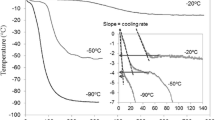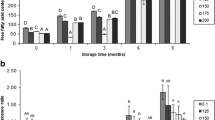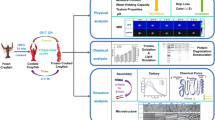Abstract
Differential scanning calorimetric determination of glass transition temperature in the freeze-concentrated matrix (\( T_{\text{g}}^{\text{'}} \)) of sea bass muscle was optimized. Conventional and modulated differential scanning calorimetry (DSC) techniques (using diverse cooling/heating rate and modulation parameters) and effect of an annealing step (−30, −20, or −15°C, 30min) were assayed. Transition was more evident using conventional DSC assays, cooling/heating rate: 10°C/min, annealing step at –20°C. A \( T_{\text{g}}^{\text{'}} \) value of –15.2 ± 0.3°C was observed for sea bass fresh muscle. This method was chosen for \( T_{\text{g}}^{\text{'}} \) determination on high-pressure (HP) treated and pressure shift freezing (PSF)—stored at –20°C—sea bass muscle. Thus, in both cases, transition at –15°C was less evident as a function of the pressure level applied, being very difficult to detect after treatment at 400 and 600MPa. It was observed that \(T_{\text{g}}^{\text{'}} \) values were shifted to slightly higher temperatures (around 1°C higher) after HP treatment at 400 and 600MPa. The present work constituted a first approach to the study on the effect of HP on the glass transition of a complex food matrix, giving useful information about stability of the frozen food.








Similar content being viewed by others
References
Brake, N., & Fennema, O. (1999). Glass transition values of muscle tissue. Journal of Food Science, 64(1), 10–15.
Cheftel, J., & Culioli, J. (1997). Effects of high-pressure on meat: a review. Meat Science, 46(3), 211–236.
Chéret, R., Chapleau, N., Delbarre-Ladrat, C., Verrez-Bagnis, V., & de Lamballerie, M. (2006). Effects of high-pressure on texture and microstructure of sea bass (Dicentrarchus labrax L.) fillets. Journal of Food Science, 70(8), 477–483.
Chevalier, D., Sequeira-Munoz, A., Le Bail, A., Simpson, B., & Ghoul, M. (2000). Effect of pressure shift freezing, air-blast freezing and storage on some biochemical and physical properties of turbot (Scophthalmus maximus). Lebensmittel-Wissenschaft Technologie, 33, 570–577.
Chung, H., Woo, K., & Lim, S. (2004). Glass transition and enthalpy relaxation of cross-linked corn starches. Carbohydrate Polymers, 55, 9–15.
Delgado, A., & Sun, D.–W. (2002). Desorption isotherms and glass transition temperature for chicken meat. Journal of Food Engineering, 55, 1–8.
Denys, S., Schlüter, O., Hendrickx, M., & Knorr, D. (2002). Effects of high pressure on water-ice transitions in foods. In Hendrickx, & Knorr (Eds.) Ultra high-pressure treatments of foods, chapter 8 (pp. 215–248). New York, USA: Kluwer Academic/Plenum Publishers.
Gill, P., Sauerbrunn, S., & Reading, M. (1993). Modulated differential scanning calorimetry. Journal of Thermal Analysis, 40, 931–939.
Goff, H. (1994). Measuring and interpreting the glass transition in frozen foods and model systems. Food Research International, 27, 187–189.
Hashimoto, T., Suzuki, T., Hagiwara, T., & Takai, R. (2004). Study on the glass transition for several processed fish muscles and its protein fractions using differential scanning calorimetry. Fisherie Science, 70, 1144–1152.
Heremans, K. (2002). The effects of high pressure on biomaterials. In Hendrickx, & Knorr (Eds.) Ultra high pressure treatments of foods, chapter 2 (pp. 23–51). New York, USA: Kluwer Academic/Plenum Publishers.
Inoue, C., & Ishikawa, M. (1997). Glass transition of tuna flesh at low temperature and effects of salts and moisture. Journal of Food Science, 62(3), 496–499.
Jensen, K., Jorgensen, B., & Nielsen, J. (2003). Low-temperature transitions in cod and tuna determined by differential scanning calorimetry. Lebensmittel-Wissenschaft Technologie, 36, 369–374.
Jiang, Z., Imrie, C., & Hutchinson, J. (2002). An introduction to temperature modulated differential scanning calorimetry (TMDSC): a relatively non-mathematical approach. Thermochimica Acta, 387, 75–93.
Kowalczyk, W., Hartmann, C., Luscher, C., Pohl, M., Delgado, A., & Knorr, D. (2005). Determination of thermophysical properties of foods under high hydrostatic pressure in combined experimental and theoretical approach. Inner Food Science & Emerging Technologies, 6(3), 318–326.
Levine, H., & Slade, L. (1989). Response to the letter by Simatos, Blond, and Le Meste on the relation between glass transition and stability of a frozen product. Cryo Letters, 10, 347–370.
Ludikhuyze, L., & Hendrickx, M. (2002). Effects of high pressure on chemical reactions related to food quality. In Hendrickx, & Knorr (Eds.) Ultra high-pressure treatments of foods chapter 6, (pp. 167–188). New York, USA: Kluwer Academic/Plenum Publishers.
Michel, M., & Autio, K. (2002). Effects of high pressure on protein and polysaccharide-based structures. In Hendrickx, & Knorr (Eds.) Ultra high-pressure treatments of foods chapter 7 (pp. 189–214). New York, USA: Kluwer Academic/Plenum Publishers.
Nesvadba, P. (1993). Glass transition in aqueous solutions and foodstuffs. In Blanshard, & Lillford (Eds.) The glassy state in foods (pp. 523–526). Loughborough, UK: Nottingham University Press.
Ohshima, T., Ushio, H., & Koizumi, C. (1993). High-pressure processing of fish and fish products. Trend in Food Science and Technology, 4, 370–375.
Orlien, V., Risbo, J., Andersen, M., & Skibsted, L. (2003). The question of high- or low- temperature glass transition in frozen fish. Construction of the supplemented state diagram for tuna muscle by differential scanning calorimetry. Journal of Agriculture and Food Chemistry, 51, 211–217.
Rahman, M., Kasapis, S., Guizani, N., & Al-Amri, O. (2003). State diagram of tuna meat: freezing curve and glass transition. Journal of Food Engineering, 57, 321–326.
Rasmussen, D. (1969). A note about “ phase diagrams” of frozen tissue. Biodynamical, 10, 333–339.
Reading, M., Luget, A., & Wilson, R. (1994). Modulated differential scanning calorimetry. Thermochimica Acta, 238, 295–307.
Simatos, D., & Blond, G. (1993). Some aspects of the glass transition in frozen foods systems. In Blanshard, & Lillford (Eds.) The glassy state in foods (pp. 395–415). Loughborough, UK: Nottingham University Press.
Simatos, D., Faure, M., Bonjour, E., & Couach, M. (1975). Differential thermal analysis and differential scanning calorimetry in the study of water in foods. In Duckwroth (Ed.) Water relations in foods (pp. 193–209). London, UK: Academic Press.
Slade, L., & Levine, H. (1991). Beyond water activity: recent advances based on an alternative approach to the assessment of food quality and safety. Critical Review in Food Science and Nutrition, 30, 115–360.
Slade, L., & Levine, H. (1995). Water and glass transition—Dependence of the glass transition on composition and chemical structure: special implications for flour functionality in cookie baking. Journal of Food Engineering, 24, 431–509.
Tironi, V., de Lamballerie, M., & Le Bail, A. (2007). Effects of pressure shift freezing and pressure assisted thawing on sea bass (Dicentrarchus labrax) quality. Journal of Food Science, 72(7), 381–387.
Urrutia-Benet, G., Balogh, T., Schneider, J., & Knorr, D. (2007). Metastable phases during high-pressure–low-temperature processing of potatoes and their impact on quality-related parameters. Journal of Food Engineering, 78(2), 375–389.
Zhu, S., Ramaswamy, H., & Le-Bail, A. (2005). High-pressure calorimetric evaluation of ice crystal ratio formed by rapid depressurization during pressure-shift freezing of water and pork muscle. Food Research International, 38(2), 193–201.
Acknowledgment
The authors wish to thank R. Chéret and D. Queveau for their technical support. This study has been carried out with financial support from the Commission of the European Communities, FP5 QLK1-CT-2002–02230 “SAFE ICE” project. It does not necessarily reflect its views and in no way anticipates the Commission’s future policy in this area.
Author information
Authors and Affiliations
Corresponding author
Rights and permissions
About this article
Cite this article
Tironi, V., de Lamballerie-Anton, M. & Le-Bail, A. DSC Determination of Glass Transition Temperature on Sea Bass (Dicentrarchus labrax) Muscle: Effect of High-Pressure Processing. Food Bioprocess Technol 2, 374–382 (2009). https://doi.org/10.1007/s11947-007-0041-y
Received:
Accepted:
Published:
Issue Date:
DOI: https://doi.org/10.1007/s11947-007-0041-y




